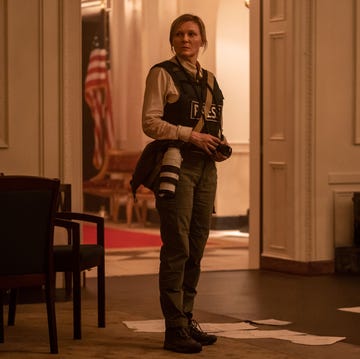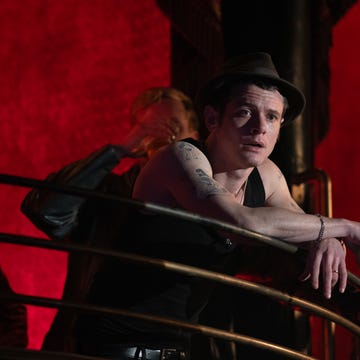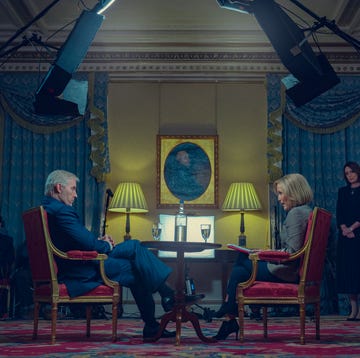5 Things In 'Star Wars' That Make Absolutely No Sense
Our friends at Popular Mechanics have gone deep on the machines in a galaxy far, far away

There are no shortage of ways in which a person could take issue with the war machines in the Star Wars universe. But instead of the illogical design of the lightsaber or the TIE fighter, we want to focus on the armored vehicles. Even in a universe of magical space samurai and moon-sized space stations, tanks are ever-present as alpha predators of ground battle. Yet the way the filmmakers imagined them violates many tenets of common sense weapons design.
AT-AT

The whole point of a troop transport is to get fighters and their equipment to the front lines without exhausting them in the process. To do it, a troop transport needs range and speed to achieve the element of surprise during an advance, and armor to protect the troops and gear inside. Which makes us wonder what the Star Wars weaponeers were thinking when they debuted the AT-AT in The Empire Strikes Back. The name stands for "All Terrain All Transport," but even with all these longstanding rules for making a good ride, the designers gave the Empire a bunch of top-heavy four-legged walkers that are vulnerable, slow and easy to spot.
I don't want to come off like someone who doesn't support quadruped robots on the battlefield. There's a time and a place where this design makes complete sense, such as the four-legged robots that could serve as battlefield mules for foot soldiers to haul gear or wounded troops. Four legs is an advantage to a robot mule that needs to keep up with Marines on a long-range combat patrol through rough terrain.
However, they are not well suited for front-line action. Scaling up a 4-legged design to mammoth AT-AT walkers brings few advantages, and numerous disadvantages. Sure, the AT-AT could step over many obstructions, like trees and boulders. But steeper inclines and the inability to roll upright—it's awfully boxy for such a maneuver; a barrel shape would help—makes this a dangerous ride.
Although the engineers of the Star Wars universe have perfected dynamic stability, allowing a legged robot to recalibrate its balance after each step just like a person does, we're still left with a nagging question. Why choose legs at all? The walker advances at a ponderously slow pace, making a ton of noise in the process. AT-ATs are so large they can be spotted visually and on radar. Since there's no element of surprise here, an Imperial general might as well fly a large ship or hovercraft to the target. Of course, the movie explains that the walkers' mission is to take down the Rebels' shield generator, but why that shield doesn't extend to the ground—allowing the mammoth AT-ATs to get through—confounds me. If they can walk through, why couldn't the Empire simply launch low-flying aircraft or high-speed hovercraft to ferry troops?
The AT-AT even fails at its primary advantage, the fact that it's armored vehicle. Sure, it's built solidly. But these things have such well-known weak spots that rebels arm their fighters with harpoon cables to trip them up. (What else are they good for, hunting space whales?) Yes, Hoth fell to the Empire, but the invasion would have been quicker, easier, and more effective with waves of smaller, conventional ground vehicles backed by close air support.
Hailfire Droid Tank

Even when Star Wars gets it right, like designing vehicles with wheels instead of legs, they tend to get it wrong. Take the Hailfire Droid Tank, featured in Attack of the Clones. Having a mobile, missile-firing vehicle is a good idea, but it's a better idea to make sure it can operate in many environments. With that in mind, what's with the hoop wheels?
In reality, robots suspended on the axle between wheels are a popular design, as it gives them the ability to right themselves as they traverse rough terrain. So that part makes some sense. But larger wheels are not always better, as a group of CalTech and NASA experimenters found during tests of a tethered 'bot in 2009. "In an attempt to increase the size of the obstacles that Axel could easily travel over, 26-inch mountain bike tires were mounted onto the frame," they wrote. "These were more than double the diameter of the original spiked wheels, and so we expected much better performance over obstacles. Nevertheless, experiments carried out in the mini Mars Yard at the Jet Propulsion Laboratory did not confirm our hypothesis." They learned that the larger wheels would turn and slide around obstacles when they made contact, whereas smaller wheels could grip and go over rocks.
So oversized wheels make little sense. How about the angle of those wheels? It's called negative camber, and racecars use this trick to keep the tread on the ground (providing more grip) while the vehicle turns. Why that would be important for this droid tank, with its narrow wheels and insanely tilted angle, is hard to fathom.
In a brief aside, we at Popular Mechanics had a brief debate over whether or not this tank needs an andriod to serve as a pilot. If so, is it still considered "unmanned?" And why have a robot drive a tank when you can just make a tank that drives itself? These are the things that keep us up at night.
Self-Propelled Heavy Artillery Walker

Legs again, and lots of them! There's no reason why this vehicle, used by the Republic during the Clone Wars, is not on tracks or wheels, which would be easier to maintain than lines of stomping metallic feet.
But the thing to look at here is that dish, presumably used to harness some energy to focus a beam. That makes zero sense. When I see a dish like this on a weapon, I immediately think radar targeting. But when it's at the end of a barrel, as in this case, I think of a microwave weapon. Microwaves fly all over the place unless they are somehow focused. A curved dish can do this, as is the case in the Pentagon's non-lethal Active Denial System, also known as the "pain ray." But microwaves are invisible, so what's the deal with all that lightning crackling at the end of the barrel?
OG-9 Homing Spider Droid

Whenever I see biomorphic robots in movies, I know they are only there to look menacing or cute. But when I see a mechanical insect, like the Spider Droid first seen in Attack of the Clones, I have to pause and consider if its design makes sense.
The reason I give these props the benefit of the doubt is because of a real-life robot named RoboSimian, designed by JPL to compete in the DARPA Robotics Competition. The robot shares a four-legged design with the cinematic autonomous weapon. The use of four legs means the designers prize "stability over dynamics," to borrow the words of JPL. In other words, this design can travel over rough terrain, but it moves slowly. Indeed, the droid is seen moving slowly and picking its shots in the films.
Here's the problem: In modern (and future) combat, mobility equals survival. Once you shoot your weapon, a smart driver (or algorithm) knows to move right away to avoid counter-fire. There are no "shoot-and-scoot" tactics possible with a robot that carefully picks each step. And this design can't withstand much damage. Knocking out even one leg would disable the whole tank.
Robots that move slower than humans don't belong on the battlefield.
Blasters and Laser Weapons

Let's move from how Star Wars tanks move to how they shoot. The mainstay weapon in Star Wars, whether it's a handgun or tank's main cannon, is the "blaster."
There is some debate as to what a blaster actually is. Some say it's a laser weapon that fires destructive pulses of light. Others claim that blasters are beam accelerators, creating streams of supercharged atomic or subatomic particles to cause heat damage. Some say the weapons we see on screen are a mix of both. Whatever they are, their shots wouldn't actually be visible like they are in the Star Wars universe. Lasers move at the speed of light, and beam weapons travel nearly that quickly (unless you're in Star Wars, in which case they go a pokey 130 mph).
In reality, one of the biggest advantages of these weapons is that they strike so quickly that they are hard to defend. But blaster and laser fire is not only slow, it's also conveniently color-coded on Star Wars battlefields. Making those pulses visible must be intentional. But why? The blasters could be using the color to help aim. This is a common tactic in real world history: one or two rounds in a clip firing an illuminated round instead of a bullet can help aim, communicate with friendly forces, and (sometimes) serve as a warning that your clip is nearing an end.
One big knock against real-life tracers is that they expose your position to enemies. But on actual battlefields, tracers are most often used to adjust fire from heavy machine guns, and if you're shooting one of them, there's a good chance an enemy will know it. Yet Star Wars blasters large and small—even ones used by snipers—fire colored bolts. Makes no sense. No wonder Jedis can deflect them at will with a plasma torch. Sorry, a "lightsaber."
Note: For some real military lasers, see the Laser Weapons System being used aboard USS Ponce in the Persian Gulf. For real world particle beam space experiments, look up Beam Experiments Aboard Rocket test that lofted a hydrogen beam weapon into low earth orbit in 1989. More recent work is being done to "pinch" plasma, creating bits of ionized energy that have temperatures of 1.8 billion F. Read up on that craziness at the Focus Fusion Society.
Joe Pappalardo is a contributing writer at Popular Mechanics and author of the new book, Spaceport Earth: The Reinvention of Spaceflight.
Watch Next


Classic Spy Films, From 'Argo' to 'Austin Powers'

The Best Sex Movies: A Countdown

‘Challengers’ Review: Game, Set and Mismatch

‘Civil War’ Review: Snap Unhappy







